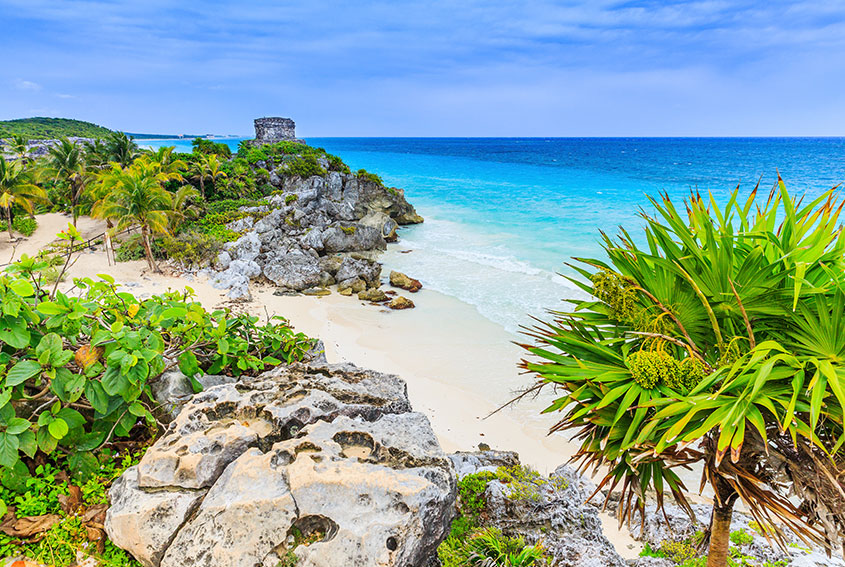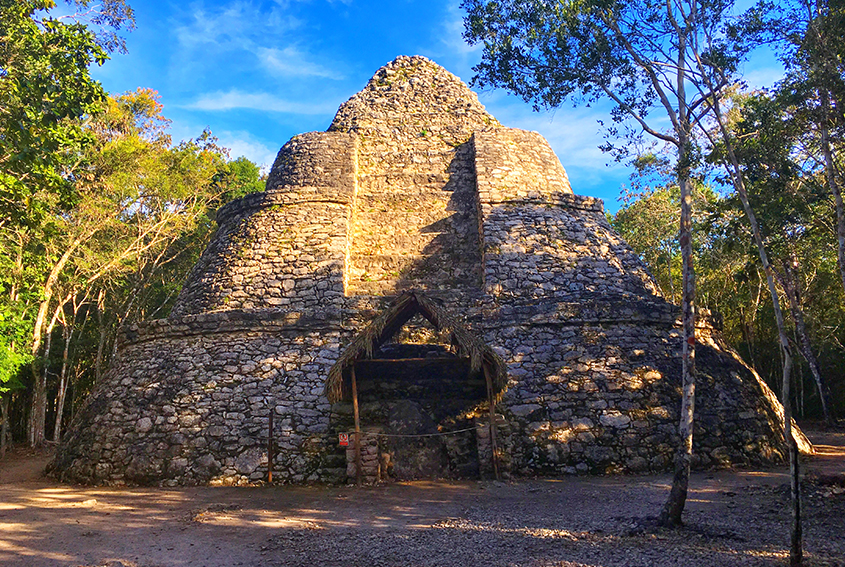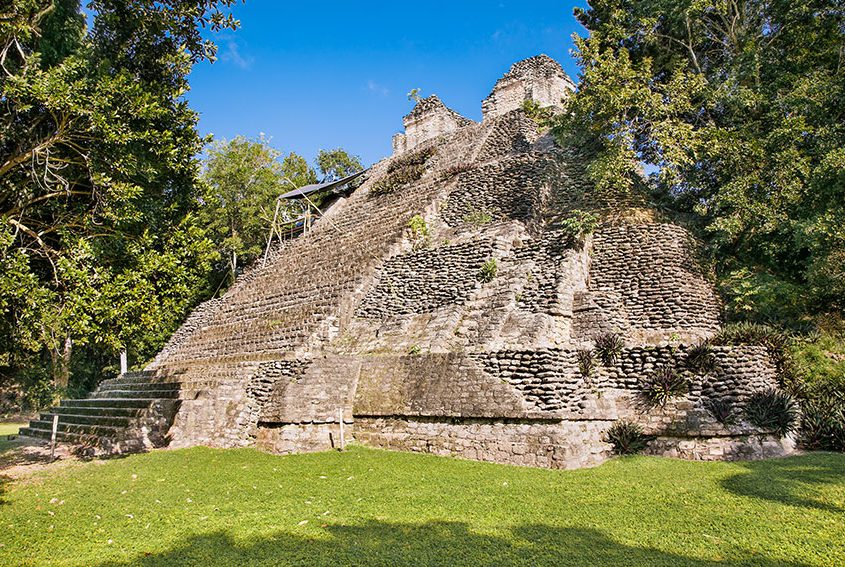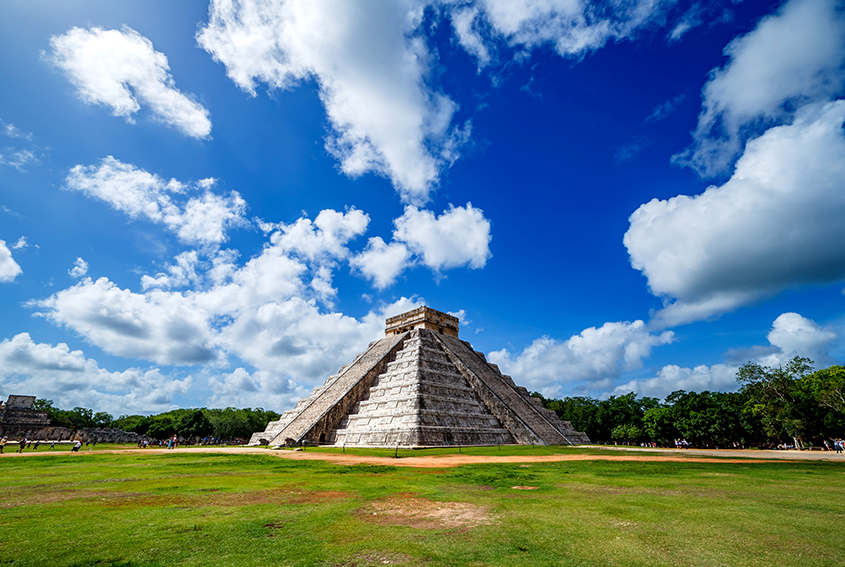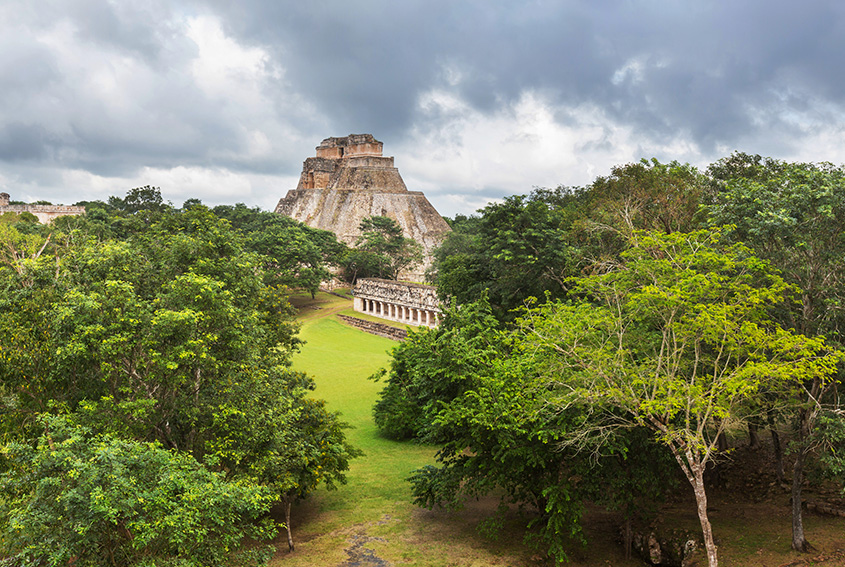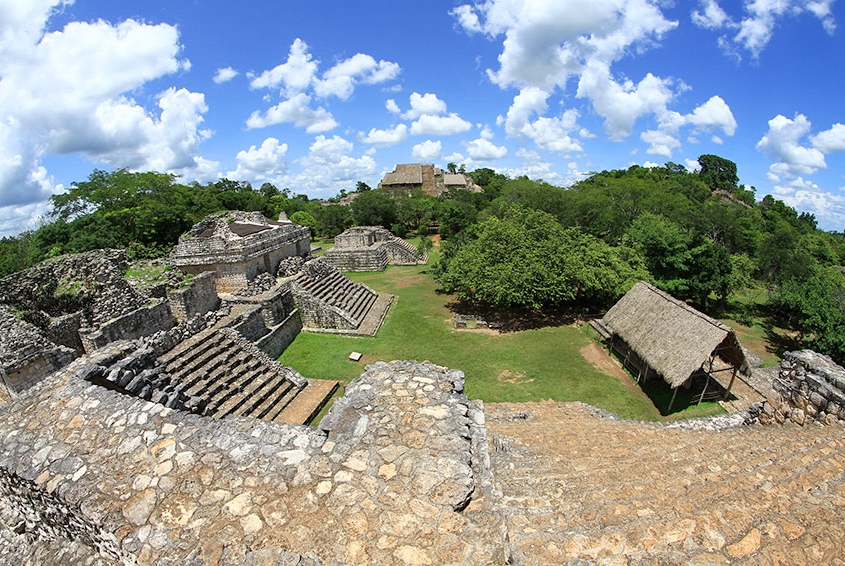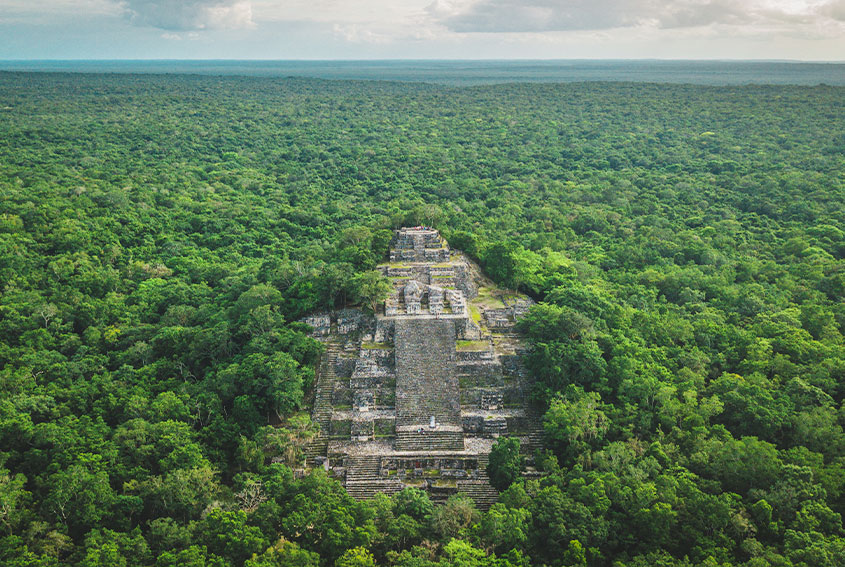Maya explorer – Blog
Take a journey in history on your next Cancun vacation and become a Maya explorer. Follow in the footsteps of the intrepid adventurers who discovered mysterious jungle cities that pepper the landscape of the Yucatan Peninsula. Visit the area’s famous archaeological sites and see temples where Mayan priests performed rituals to honor the gods, observatories where astronomers scanned the night skies looking for portents in the stars, and ancient palaces inhabited by mighty rulers. All are wonders of art and architecture, rich in stucco carvings and they have endured the passage of time. Here are some of our favorites and there are many more to discover in the Maya World. How many have you visited?
Quintana Roo
Start your journey of discovery in the Mexican Caribbean. There are ancient Maya temples in the Cancun area, the Riviera Maya and southern Quintana Roo.
Tulum
Crowning a cliff overlooking the Caribbean, Tulum is one of the Maya World’s most spectacular sites. “Tulum” means “wall” in Maya, a reference to the stone barrier that protects it on three sides, the fourth being the sea, but in ancient times the city was known as “Zama,” the Maya word for “dawn.”
An inscription on a stela or standing stone found at the site reveals that Tulum was inhabited as far back as A.D. 564 although it reached its peak during the post-Classic period (1250–1521) as a port on the sea and land trade routes.
The principal building at Tulum is the El Castillo temple; other important groupings are the Temple of the Descending God with a diving deity on the facade who was at the center of a cult that spread through the Yucatan, Temple of the Frescos and the House of the Columns.
Coba
From Tulum on the Riviera Maya coast, head inland to the ancient city of Coba (25 miles/41 km from the coast), one of the Maya World’s largest archaeological sites.
Coba means “waters ruffled by the wind” in Maya and the pyramids and temples at this jungle site are clustered around four shallow lakes. The city reached its peak during the Maya Classic period, A.D. 250-900, when it was an important trade center.
The most recent discovery at the site is the identification of the ancient dynasty that once dominated Coba and the names of 14 rulers, including two queens, through the study of hieroglyphic inscriptions carved on stelae and wall tablets. This powerful house ruled the city from around A.D. 500 to A.D. 780 and had links to Ek Balam, Calakmul and cities in the Peten region of northern Guatemala, including Tikal.
The principal buildings or groups at Coba are Nohoch Mul, at 42 meters, the tallest pyramid in the northern Yucatán, the Cobá group, La Iglesia (another pyramid), Las Pinturas, the Ball Court, Xaibe and the Macanxoc group which has nine circular altars and eight stelae.
Cobá is also famous for the sacbes or Mayan roads that radiate from the heart of the city. The longest sacbe in the Maya World links the city with the site of Yaxuná, near Chichén Itzá and is 101 km long.
Kohunlich
The most famous archaeological site in southern Quintana Roo, 60 kilometers to the west of Chetumal via Highway 186, Kohunlich was first reported in 1912 by Raymond Merwin. The name “Kohunlich” is derived from the English words “cohune,” a native palm tree, and “ridge.”
Excavation work has revealed that the city was founded around 200 B.C. and reached its peak during the Classic period of Mayan history (A.D. 200 – 1000). Building work appears to have ceased around 1200.
Kohunlich is famous for the huge stucco masks that flank the staircase of the Temple of the Masks. Archaeologists believe that they depict the city’s rulers who chose to identify themselves with the sun god, Kinich Ahau, to legitimize their rule. Other important groups of buildings are the Acropolis, the Courtyard of the Stelae, the Palace of the King, Merwin Plaza and the elite residential areas known as the 27 Steps Complex and Pixa’an.
Dzibanche
Located in the jungle 81 kilometers northwest of Chetumal via Highway 186, Dzibanche is an ancient city that is still revealing its secrets. Discovered in 1927 by Thomas Gann, Dzibanche means “writing on wood” in Maya, a reference to the calendar inscriptions found on the carved lintel of zapote wood above the doorway to Temple VI.
Experts believe that Dzibanche was the largest and most important city in southern Quintana Roo in ancient times and may have been involved in a power struggle with other city-states in the region such as Calakmul in Campeche. The city reached its peak between A.D. 300 and 1200.
The most important groups of buildings are the Temple of the Lintels; the Gann Plaza, which is flanked by the Temples of the Cormorants, Captives and Toucans; Xibalba Plaza, the site of the Temple of the Owl and the North and South Palaces.
An outlying district of the city, Kinichna (“House of the Sun” in Maya) is located about two kilometers north of Dzibanche and is dominated by a temple called the Acropolis.
More Quintana Roo sites
Other archaeological ites to visit in Quintana Roo include El Rey, San Miguelito and El Meco in the Cancun area, Xel-Ha and Muyil, San Gervasio in the island of Cozumel, and Chacchoben, Ixcabaal and Oxtankah in the south of the state.
Yucatan
The Yucatan landscape is dominated by two majestic cities that have won World Heritage status, but there are many more sites to discover.
Chichen Itza
Yucatan’s most famous archaeological site, Chichen Itza is a Cancun vacation highlight. Once a powerful city state, controlling much of the peninsula, it was a vast metropolis with ties to other Maya cities in the Yucatan and to central Mexico cultures. Its oldest temples and palaces are built in the Maya style and are profusely decorated with masks of the Maya rain god Chac whereas later buildings in the Great Plaza show central Mexican influence in architecture and art.
The city stretched for around 20 square kilometers and only three percent of this vast archaeological site is open to the public in the area comprising the Great Plaza, the Observatory and Las Monjas. Archaeologists are still excavating and restoring many more temples in the surrounding forest, known as Chichen Viejo, and a trail is now open to visit a cluster of buildings in this area.
The Great Plaza is the site of the famous Pyramid of Kukulcan, the Temple of the Warriors, Temple of a Thousand Columns, Tzompantli, Temple of the Jaguars and the Ball court, the largest discovered to date in Mesoamerica. From this sacred square it is a short walk to the Sacred Cenote, the Ossuary, the Observatory and Las Monjas. These majestic temples have earned Chichen Itza a place on the UNESCO World Heritage list and years ago it was voted one of the New Seven Wonders of the World in an online poll.
Uxmal
An hour’s drive south of Mérida, Uxmal is one of the loveliest ancient cities in the Maya World. During the Late Classic period (A.D. 600-900), it was a regional capital, controlling southwest Yucatán and a chain of smaller cities referred to as the Puuc Route: Kabah, Sayil, Xlapak and Labná.
Apart from location, these sites share a unique architectural and artistic style called Puuc. In recognition of their outstanding cultural worth, UNESCO declared them a World Heritage area in 1996.
Highlights at Uxmal are the Magician’s Pyramid, the Nuns’ Quadrangle, a gracious courtyard surrounded by four palace-like buildings with magnificent friezes and the impressive Palace of the Governor on a mound and platform overlooking the site. Other buildings of note are the Temple of the Birds, the Great Pyramid, The House of the Turtles and El Palomar.
Puuc Route
Thirty minutes south of Uxmal, Kabah is the second largest site in the Puuc hills and was one of its vassals. It is famous for the Codz Pop, or the Palace of the Masks, a name that does justice to its magnificent façade consisting of 250 masks depicting Chaac, the Maya rain god.
Seven kilometers south of Kabah is Sayil, which means “place of the ants” in Maya. The principal building on site is the three-tiered Palace, a long building containing 94 chambers, porticos, columns, Chaac masks and sculptures of the descending or diving god, also seen in Tulum on the Caribbean coast.
The smallest of the Puuc Route sites, Xlapak is best known for the Palace, a tiny but richly carved building in a forest clearing.
Ten kilometers to the east of Sayil, Labna is famous for its huge arch, which was the gateway between the ceremonial plaza and a courtyard surrounded by palaces in ancient times. The arch has an open work roof comb and its finely carved façade features Chaac masks, Mayan huts, nobles and geometric motifs.
Ek Balam
A 20-minute drive to the north of Valladolid is the ancient city of Ek Balam, which means “black jaguar or star jaguar” in Maya. The city flourished between A.D. 250-1200 and had ties with cities such as Chichen Itza. Archaeologists believe that it was an artistic center, and its crowning glory is the façade on the upper level of the Acropolis, the principal building, which features magnificent stucco figures of the gaping jaws of the earth monster, serpents and an ancient lord thought to be the first ruler of the city. The figure’s ornate feathered headdress resembles wings and has led many people to refer to him as “el angel” or the angel.
Campeche
If you travel to southern Quintana Roo, you’ll want to continue into the neighboring state of Campeche to visit Calakmul, a jungle city that is also a World Heritage Site.
Calakmul
Deep in the jungle of the Calakmul Biosphere Reserve in southern Campeche, close to the Guatemalan border, the ancient city of Calakmul was a major Maya power in the Classic period of Maya history. A dynasty of rulers had a bitter rivalry with the city of Tikal and were at war with it for almost a century. The study of hieroglyphic inscriptions carved on Calakmul’s many stelae or standing stones has revealed events including battles, victories, alliances and successions.
Climb the twin pyramids for panoramic views of the forest with the Danta Pyramid at the Guatemalan site of El Mirador visible in the distance.
The huge site of Calakmul is also famous for the jade masks found in the tombs of ancient rulers buried deep in temples and palaces.
Calakmul is a UNESCO World Heritage Site, and the surrounding jungle is a haven for wildlife, including spider and howler monkeys, deer, jaguar and puma, ocelot, coatimundi, peccary and the tapir. Bird species include ocellated turkey, toucans and the rare king vulture. Millions of bats dwell in a cave in the reserve, leaving it at twilight to feed on insects in a spiraling plume that resembles smoke.
Due to its remote location, guided tours are the best way to explore Calakmul.
Other archaeological sites in southern Campche include Xpujil, Becan, Chicanna, Rio Bec and Balamku, among others.
Edzna
The ancient city of Edzná was settled in 600 B.C. and became an important regional center from A.D. 400 to 1000 with ties to cities in the Yucatan and the Peten region of Guatemala. Its inhabitants developed a system to store rainwater and irrigate their crops in the valley. The city is best known for its mulitiered temple, the Gran Acropolis, the Platorm of the Knives, Noholna, and more.
The architecture is a mixture of Puuc and Chenes architectural and artistic styles and there are two huge masks of Kinich Ahau, the sun god.
Become a Maya explorer with Thomas More Travel
Plan your Maya adventures with Thomas More Travel. Visit the Thomas More Travel website for details of trips to Chichen Itza, Tulum, Coba, Ek Balam, Uxmal and Muyil or call in at the travel desk in the lobby of your resort.
If you like exploring on your own and have plenty of time, the Tren Maya railway connects Cancun, Valladolid, Piste (Chichen Itza), Merida, Campeche and Palenque so that you can explore the region’s major archaeological sites.

